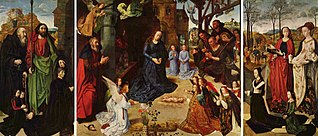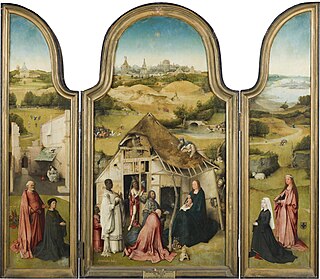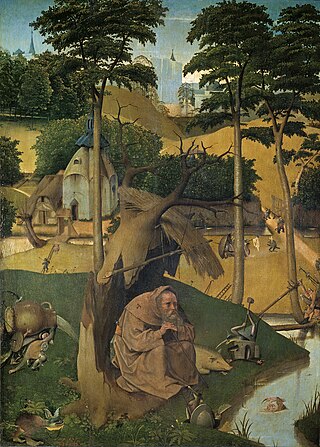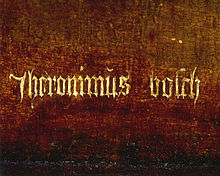
Hieronymus Bosch was a Dutch painter from Brabant. He is one of the most notable representatives of the Early Netherlandish painting school. His work, generally oil on oak wood, mainly contains fantastic illustrations of religious concepts and narratives. Within his lifetime his work was collected in the Netherlands, Austria, and Spain, and widely copied, especially his macabre and nightmarish depictions of hell.

The Garden of Earthly Delights is the modern title given to a triptych oil painting on oak panel painted by the Early Netherlandish master Hieronymus Bosch, between 1490 and 1510, when Bosch was between 40 and 60 years old. It has been housed in the Museo del Prado in Madrid, Spain since 1939.

The Temptation of Saint Anthony is an often-repeated subject in the history of art and literature, concerning the supernatural temptation reportedly faced by Saint Anthony the Great during his sojourn in the Egyptian desert. Anthony's temptation is first discussed by Athanasius of Alexandria, Anthony's contemporary, and from then became a popular theme in Western culture.

The Portinari Altarpiece or Portinari Triptych is an oil-on-wood triptych painting by the Flemish painter Hugo van der Goes, commissioned by Tommaso Portinari, representing the Adoration of the Shepherds. It measures 253 x 304 cm, and is now in the Galleria degli Uffizi in Florence, Italy. This altarpiece is filled with figures and religious symbols. Of all the late-fifteenth-century Flemish artworks, this painting is said to be the most studied.

The Haywain Triptych is a panel painting by Hieronymus Bosch, now in the Museo del Prado, Madrid, Spain. A date of around 1516 has been established by means of dendrochronological research. The central panel, signed "Jheronimus Bosch", measures 135 cm × 200 cm and the wings measure 147 cm × 66 cm. The outside shutters feature a version of Bosch's The Wayfarer.

The Seven Deadly Sins and the Four Last Things is a painting attributed to Hieronymus Bosch or to a follower of his, completed around 1500 or later. Since 1898 its authenticity has been questioned several times. In 2015 the Bosch Research Conservation Project claimed it to be by a follower, but scholars at the Prado, where the painting is on display in a sealed case, dismissed this argument. The painting is oil on wooden panels and is presented in a series of circular images.

The Museu Nacional de Arte Antiga, also known in English as the National Museum of Ancient Art, is a Portuguese national art museum located in Lisbon. With over 40,000 items spanning a vast collection of painting, sculpture, goldware, furniture, textiles, ceramics, and prints, MNAA is one of the most visited museums in Portugal.

The Conjurer is a painting by Early Netherlandish painter Hieronymus Bosch or his workshop, executed around 1502.
Death and the Miser is a Northern Renaissance painting by Hieronymus Bosch produced between 1490 and 1516 in Northern Europe. The piece was originally part of a triptych, but the center piece is missing. It is a memento mori painting, which is meant to remind the viewer of the inevitability of death and the futility of the pursuit of material wealth, illustrating the sin of greed.

The Adoration of the Magi or The Epiphany is a triptych oil painting on wood panel by the Netherlandish artist Hieronymus Bosch, executed around 1485–1500. It is now in the Museo del Prado in Madrid, Spain.

St. Jerome at Prayer is a painting of St. Jerome by Hieronymus Bosch, thought to have been completed c. 1482. Today it is housed at the Museum of Fine Arts in Ghent.

Christ Crowned with Thorns, sometimes known as Christ Mocked, is an oil on panel painting by Hieronymus Bosch. It is held in the National Gallery in London, which dates it to around 1510, though some art historians prefer earlier dates.

The Crucifixion of Saint Wilgefortis is a c. 1497 triptych by the Early Netherlandish painter Hieronymus Bosch. The subject of the painting has been uncertain, and it has also been known as the Triptych of the Crucified Martyr, or The Crucifixion of Saint Julia, but is now believed to depict Saint Wilgefortis.

The Temptation of St. Anthony is a painting of disputed authorship, attributed to either Hieronymus Bosch or a follower. It is now in the Museo del Prado, in Madrid.

The Last Judgment is a triptych by Hieronymus Bosch, created after 1482.

Saint Jerome in the Wilderness is an unfinished painting by the Italian Renaissance artist Leonardo da Vinci, dated c. 1480–1490. A recent study linked to the Lady with an Ermine carried out by Leonardo da Vinci at the same time supports this hypothesis .The composition of the painting has been drafted in monochrome onto the primed wooden panel. At an unknown date after Leonardo's death, the panel was cut into five pieces before eventually being restored into its original form.

The Triptych of Temptation of St. Anthony is an oil painting on wood panels by the Early Netherlandish painter Hieronymus Bosch, dating from around 1501. The work portrays the mental and spiritual torments endured by Saint Anthony the Great, one of the most prominent of the Desert Fathers of Egypt in the late 3rd and early 4th centuries. The Temptation of St. Anthony was a popular subject in Medieval and Renaissance art. In common with many of Bosch's works, the triptych contains much fantastic imagery. The painting hangs in the Museu Nacional de Arte Antiga in Lisbon.

The Last Judgment is a triptych of disputed authorship, either by Hieronymus Bosch, his workshop, or a collaboration between artist and workshop. It was created after 1486.
Proto-Surrealism is a term used for Surrealism avant-la-lettre. It is the study of various forms of art, literature, and other mediums that correspond to, reference, or share similarities to the 20th-century art movement known as Surrealism. This definition is considered a controversial topic, with many debating the suitability of the term surrealism to describe these bodies of work and instead opting to use the term Fantastique or Fantastic Art.


















